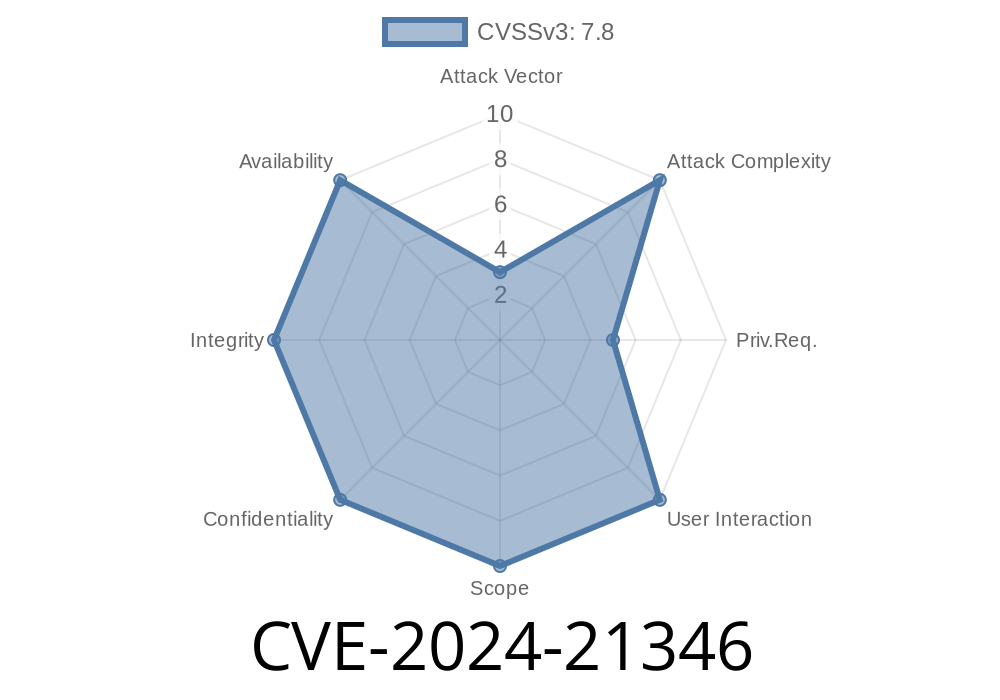A new security vulnerability, labeled as CVE-2024-21346, has been discovered in the wild, affecting the Win32k component of the Microsoft Windows Operating System. This crucial flaw, if successfully exploited, can enable attackers to attain elevated privileges on the compromised system, allowing them to execute arbitrary code, tamper with data, and bypass security controls. In this long read, we will be examining the root cause of this issue, how it can be exploited, and the potential mitigation steps that can be applied to ensure your system stays secure. Also, we will provide code snippets and point to original references to help you gain a better understanding of the technicalities involved.
Win32k Elevation of Privilege Vulnerability: The Root Cause
The vulnerability, identified as an Elevation of Privilege (EOP) flaw, lies in the win32k.sys core kernel component of the Windows operating system. The core kernel component is responsible for managing user-mode Graphical User Interface (GUI) objects, such as windows, menus, and cursors, which interact with the system's user interface. This vulnerability stems from the improper handling of certain objects in the memory, leading to a situation known as a "use-after-free" vulnerability. The following code snippet demonstrates the improper handling of objects in memory:
// Vulnerable code snippet
void Win32kObjHandler(ULONG_PTR objPtr) {
Win32Object *pObj = (Win32Object *)objPtr;
if (pObj->dwFlags & OBJ_INUSE) {
// The object is in use and cannot be freed
return;
}
// Free the object and set the pointer to NULL
ExFreePoolWithTag(pObj, 'k32W');
pObj = NULL;
}
As seen in the code snippet above, there is a potential for the Win32Object (pObj) to be accessed even after it has been freed, leading to a use-after-free vulnerability. An attacker can exploit this bug and leverage it to gain elevated privileges on the compromised system.
Exploiting CVE-2024-21346
An attacker can exploit this vulnerability by running a specially crafted application on the target machine to launch the flaw's execution and elevate their privileges. The user executing the malicious application must already be logged onto the system – the exploit does not work remotely.
This exploit has been detailed and demonstrated by the researcher @_ch1ng00u, who has provided proof-of-concept (PoC) code and a detailed explanation of its inner workings in their blog post, available here: Exploiting Win32k's use-after-free bug - CVE-2024-21346 (ch1ng00u.com).
Mitigating and Defending Against CVE-2024-21346
Microsoft has released a security update that addresses the CVE-2024-21346 vulnerability. It is highly recommended to apply this patch as soon as possible to secure your system from potential exploitation. The security update can be found in the Microsoft Security Response Center's advisory page for CVE-2024-21346: CVE-2024-21346 | Win32k Elevation of Privilege Vulnerability (microsoft.com).
In addition to applying the patch, organizations are advised to follow best practices when it comes to securing their systems:
Restrict user privileges and enforce the principle of least privilege.
3. Limit the attack surface by keeping only the required applications and services running on the systems.
Conclusion
CVE-2024-21346 is a critical vulnerability in the win32k.sys core kernel component of Windows, which, if exploited, allows attackers to elevate their privileges and potentially compromise the targeted system. Through a thorough understanding of this vulnerability, the steps to exploit it, and the mechanisms available to defend against it, organizations can better prepare themselves to face potential threats that exploit this and similar flaws.
Timeline
Published on: 02/13/2024 18:15:50 UTC
Last modified on: 02/26/2024 22:08:39 UTC
